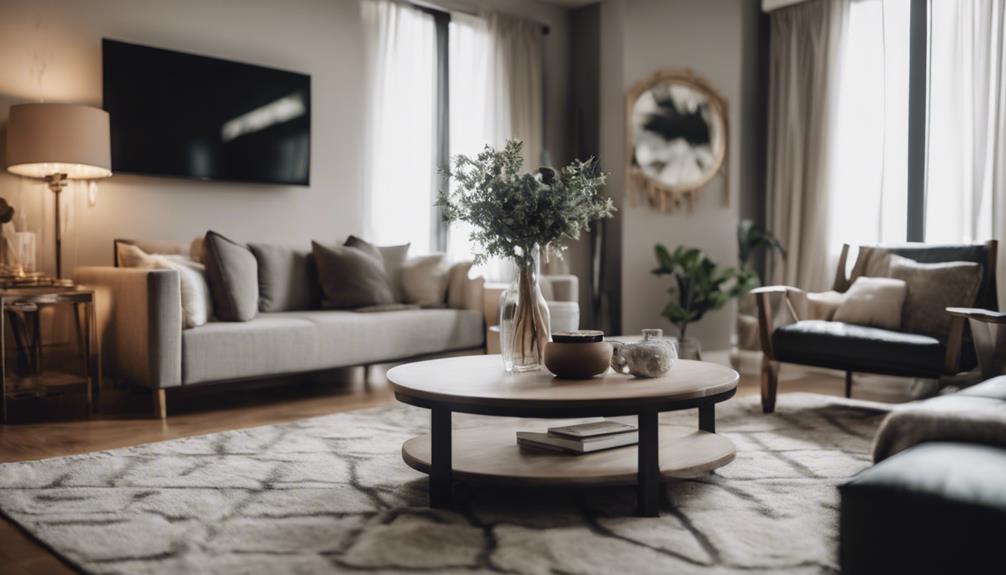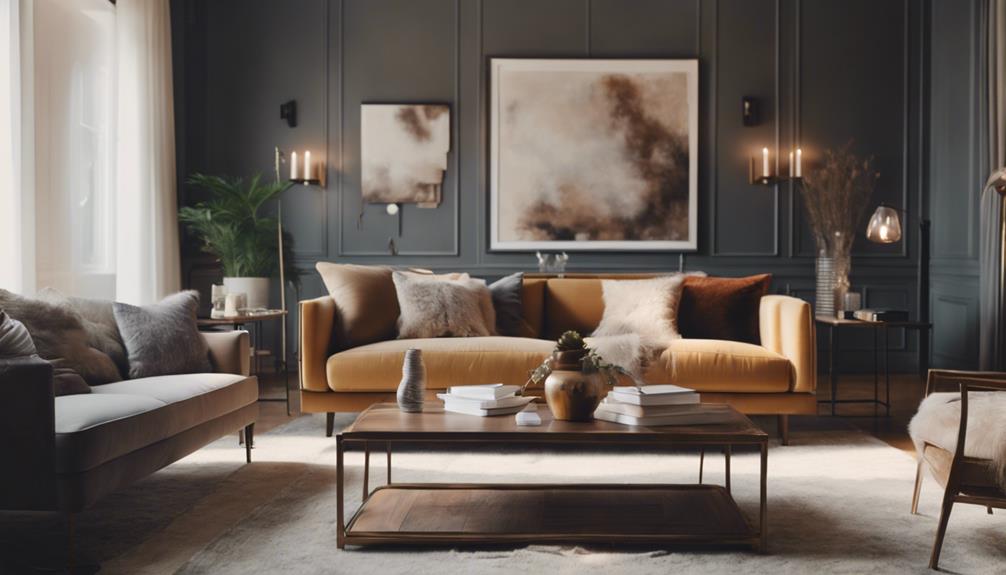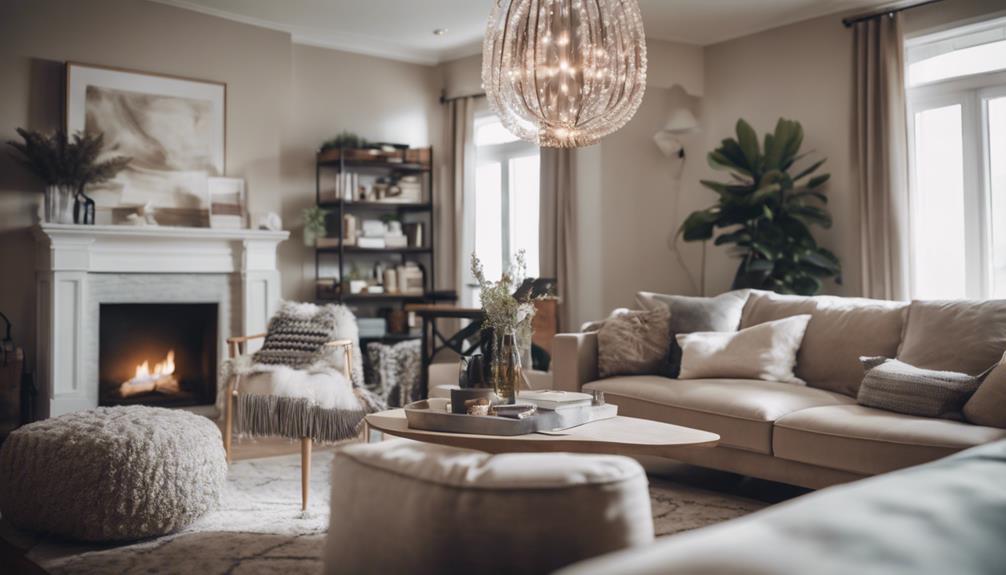When planning to stage your house to boost its market value and accelerate the sale process, anticipate starting costs of $1,500 for a modest one-bedroom home, scaling up to $4,000 for larger properties such as a five-bedroom house. These expenditures are essential investments that significantly enhance the appeal of your home.
The overall costs may vary depending on the size of the property, its location, and the extent of improvements required. By strategically investing in professional staging, you not only elevate the property's value but also increase its attractiveness to potential buyers, potentially leading to quicker offers.
Carefully considering these expenses against the anticipated advantages is crucial for a cost-effective decision.
Average Cost of Professional Home Staging
When preparing to sell your home, investing in professional home staging can be a strategic move to boost its value and accelerate the sale process. Typically, the cost of staging varies from $1,500 for a modest one-bedroom home to around $4,000 for a spacious five-bedroom residence. This investment covers a range of services, from basic enhancements to extensive transformations that might include renting stylish furniture and decorative elements. The staging arrangement usually spans 4 to 12 weeks, tailored to meet the specific needs of your property.
The advantages of professional home staging extend beyond just improving the visual appeal of your home. It strategically positions your property to stand out in the competitive real estate market, potentially leading to quicker sales and higher offers. Historically, sellers who employ professional staging services witness an impressive return, often gaining a 500% to 1000% return on their staging investment upon the sale of their property. This makes professional home staging an essential consideration for sellers aiming to maximize attractiveness to buyers and achieve optimal selling prices.
Factors Influencing Staging Costs
Factors influencing the cost of professional home staging, aimed at increasing property value and accelerating sales, include the property's size, location, condition, and the desired level of enhancement.
The size of the house affects the volume of furniture and decor needed, directly impacting staging costs. The property's location also affects costs, as urban areas might necessitate more sophisticated staging strategies compared to rural settings.
The condition of the home is crucial; properties requiring extensive repairs or modern updates often see higher staging costs. The extent of enhancement, whether it be simple tweaks or a comprehensive overhaul, significantly alters the final expense.
Additionally, the choice of design style plays a role, particularly if specific furniture rentals are needed to match a high-end aesthetic. The duration of the staging also influences costs, with typical agreements lasting from 4-12 weeks, altering the overall financial investment in professional staging services aimed at making the property more attractive to potential buyers.
Additional Expenses to Consider

When staging a house to enhance its value and accelerate the sale process, it's crucial to consider several key expenses beyond the basic staging costs.
Renting furniture to achieve a stylish and unified aesthetic is a common expense if the necessary pieces aren't already available. Investing in professional photography is essential to capture and highlight the home's best features, ensuring it stands out to potential buyers.
Marketing costs, such as online listings and high-quality printed brochures, are also vital for broad exposure. Additionally, making minor repairs or updates can significantly boost the home's appeal and justify a higher asking price.
It's also important to consider storage fees for personal items to declutter the space and present a more marketable home. By thoroughly planning for these expenses, you enhance your strategy for staging the home effectively, ultimately aiming to maximize its value and sell it more quickly.
Cost Comparison: DIY Vs Professional
When considering how to stage your house to both increase its value and expedite its sale, it's important to weigh the benefits of DIY versus professional home staging. DIY staging, which can cost little to nothing, involves decluttering and rearranging your existing furniture to enhance the space's appeal. This method might seem economical, yet it often lacks the professional design skills necessary to achieve a universally appealing aesthetic, which mightn't maximize the potential increase in property value or speed of sale.
Conversely, hiring a professional stager typically requires an investment ranging from $1,500 to $5,000, influenced by the size and condition of your home. This option brings significant advantages, such as professional design knowledge, the use of appealing and trendy furniture rentals, and the expertise to create a compelling environment that resonates with potential buyers. Although the initial outlay is greater with professional staging, the enhanced appeal can significantly raise the home's market value and attract quicker offers, thus providing a worthwhile return on investment by shortening the time on the market and maximizing sale price.
When your goal is to sell your home swiftly and for a higher price, investing in professional staging is often the more strategic choice, offering a distinct advantage over the DIY route.
Negotiating Pricing With Stagers

When negotiating pricing with professional stagers, focus on defining the scope of work and specific services that will enhance your home's appeal and speed up its sale. Discussing the extent of staging required is crucial for ensuring the services provided are precisely what's needed to maximize your home's market value.
Many stagers offer tailored packages or discounts for staging multiple rooms or the entire house, which could be beneficial if comprehensive staging is necessary. The cost of customization can vary depending on the size of your property and the specific enhancements required to appeal to potential buyers.
Stagers usually have different pricing models for initial consultation, staging, and de-staging services, and understanding these details is vital in negotiations. Ensure all fees are transparent and explicitly stated in the contract to prevent any unexpected costs.
Open discussions about the scope of staging and the intended outcomes will help you secure a pricing agreement that fits your budget and effectively increases your home's attractiveness to buyers, thereby facilitating a quicker sale.
Budget-Friendly Staging Alternatives
To enhance your home's marketability and potentially expedite its sale, consider cost-effective staging strategies that can significantly boost its value. DIY staging is a practical choice, with expenses as low as $100 for simple updates and aesthetic improvements.
Additionally, virtual staging services provide a budget-friendly option, priced between $30 and $200 per room, allowing you to showcase your home's potential without the physical hassle of rearranging furniture. Seeking advice from a professional stager, which might cost between $75 to $200, could offer crucial insights on maximizing your space's appeal.
Leveraging your existing furniture and decor in innovative ways not only saves money but also personalizes your staging efforts. The internet is a treasure trove of DIY staging tips and budget-conscious strategies that can aid homeowners in presenting their property in the most favorable light.
Value of Professional Staging Investment

Investing in professional home staging is a strategic move to elevate the value of your property and accelerate its sale. Expert staging transforms a property, making it more appealing to potential buyers and often results in a substantial increase in the sale price. With returns on investment ranging from 500% to 1000%, the financial benefits of staging are compelling.
Moreover, properties that are professionally staged tend to sell much faster, spending 73% less time on the market compared to their non-staged counterparts. This speed in sale is invaluable, reducing carrying costs and allowing sellers to move forward with their plans more quickly.
While the costs of staging a home can vary, typically ranging from $150 to $5,000 depending on the size of the property and the extent of staging required, the investment is generally well worth it. Real estate professionals consistently endorse home staging as an effective marketing tool, not just for drawing in more potential buyers but also for securing offers at a higher value.
Ultimately, staging a home is about creating a powerful first impression and distinguishing your property in a competitive real estate market. It's a proven strategy to not only enhance the aesthetic appeal of your home but also maximize its marketability and sales potential.
Return on Investment (ROI) Analysis
Optimizing the value and accelerating the sale of your property through home staging is a strategic and effective approach. Implementing top-notch staging techniques can significantly boost your property's attractiveness, drawing in a larger pool of potential buyers. Research supports that homes which are professionally staged not only sell faster but can also achieve a return on investment ranging from 500% to 1000% at the point of sale, underlining the powerful financial benefits of staging.
Furthermore, properties that are staged spend approximately 73% less time on the market than their non-staged counterparts, emphasizing how crucial staging is to the speed of the sales process. This quicker sale time isn't only convenient but also reduces the potential for additional holding costs, thereby saving money in the long run.
Investing in the staging of your home not only improves its overall presentation but also significantly contributes to its market value, often leading to higher sale prices. The costs associated with staging are variable, influenced by the size and location of the property, yet the potential for a significant return on your investment justifies this initial outlay. By focusing on enhancing your home's appeal through strategic staging, you can expedite the sale process and maximize your economic return.
Hidden Costs to Watch Out For

To optimize the value of your home and expedite its sale, it's crucial to be aware of potential hidden costs associated with house staging. When planning to employ professional staging services, it's important to consider unexpected fees such as temporary storage for personal items. Staging companies might also levy charges for relocating and arranging furniture, which can elevate the overall expenses. Moreover, incidental costs like storage for surplus items or transport fees for borrowed furniture can significantly affect your total staging budget.
Another factor to consider is the likelihood of incurring additional costs for repairs or maintenance necessary to get the property ready for staging. These extra charges can pile up, affecting your overall budget dedicated to enhancing your home's appeal. Furthermore, be prepared for possible unforeseen expenses such as last-minute alterations to the staging layout or the need for supplementary services, all of which can add to the final cost of professional staging.
Evaluating Staging Costs Vs Potential Gains
To effectively increase the value of your property and accelerate the sale process, it's crucial to consider the advantages of professional home staging. Here's an overview of how staging can enhance your home's market potential and facilitate a quicker sale:
- Investment in Staging: Typically, the cost of staging varies from $1,500 for a one-bedroom property to upwards of $4,000 for a larger, five-bedroom home. This upfront investment is pivotal in elevating the property's appeal.
- Enhanced Property Value: Staging can significantly boost your home's perceived value, often resulting in a return on investment ranging from 500% to 1000% when the property is sold.
- Accelerated Sale Process: Homes that are professionally staged usually sell about 73% faster compared to those that are not. This quicker sale process can often contribute to achieving a higher sale price due to reduced market stagnation.
- Strategic Enhancement: Despite the initial cost, staging should be viewed as a strategic enhancement that not only potentially raises the selling price but also attracts serious buyers more quickly, making it a prudent decision in the competitive real estate market.
Conclusion
The expense of professional home staging may initially seem like just another added cost, but it's a strategic investment that can significantly enhance your home's value and accelerate its sale. Factors such as the size of your home and the level of staging required will influence the costs, but the potential increase in sale price and reduced time on the market often outweigh these expenses.
By understanding the benefits and negotiating effectively with staging professionals, you can leverage home staging as a powerful tool to attract buyers quickly and fetch a higher selling price. Remember, the goal of staging is to make your home more appealing to potential buyers, thereby maximizing its market potential and ensuring a quicker sale.

